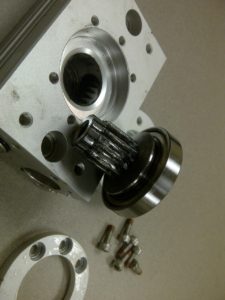An actuator is an automation device used to control or generate motion in a mechanism or a system. The energy required for controlling or generating this motion is obtained via five main sources: mechanical, hydraulic, pneumatic, thermal and magnetic.

An actuator is usually considered as a class of motor. However, there is a key difference between the two – while a motor produces rotary motion, an actuator generally produces linear, constrained motion. There are exceptions to this.
Actuators convert input energy to produce the desired type of motion.
A typical example of the application of an actuator is butterfly valve.
Types of Actuators
1. Mechanical actuators use mechanical arrangements such as lead screw, screw jack, ball screw, roller screw, wheel and axle, or Cam to convert rotary motion into linear motion.
However, mechanical actuators cannot be used in automation and can be operated only manually.
2. Hydraulic actuators use a hollow cylinder filled with a mechanical liquid and a piston inserted in it.
When an unbalanced pressure acts on the piston, it generates a force that can move external objects. These actuators can produce precise displacement along the axis of the piston.
3. Pneumatic actuators are similar to hydraulic actuators except that compressed gas is used to generate force, instead of liquids.
4. Piezoelectric actuators works by using special materials to produce electric voltage on application of mechanical pressure. Such materials expand, when voltage is applied to them.
They are used to produce extremely precise motion, and require very high voltage to operate.
5. Electro-Hydrostatic actuators have back and forth rotating pumps to draw liquid from a pressurized reservoir through a set of valves. The precise movement of rotating pump in these actuators is obtained by using digital positioners for feedback and a servo controller for controlling the pump.
These are used in inlet guide vane actuation, remote sub-sea actuation, etc.
How to Choose your Actuator
Actuators are chosen based on various mechanical parameters, including loading, stroke length, and timing.
Applicability and advantages are also important considerations for choosing actuators for your specific application.
1. Hydraulic actuators provide large forces in small sizes but need a source of hydraulic pressure.
2. Air-powered actuators use factory air.
3. Electric actuators have better controllability and are less prone to leaking, an advantage in clean–room environments. Although they have high initial costs, they are more economical in the long run.
4. Pneumatic valve actuators – double acting and spring return – use pressure differences to act as either powered or non-powered actuators.
5. Piezoelectric actuators are designed for micro-positioning and use piezoelectric crystals to produce high precision motions useful in the world of optics, semiconductor manufacturing, etc.
Other Factors To Consider
There are several other factors and parameters to consider while choosing the actuator that befits the application. A few of them are listed below.
Mounting Configuration
Once you choose your ideal actuator, you need to decide how it mounts on the device you want to actuate.
Output Torque
Output torque describes the rotational force the actuator can apply to the valve to shut it. It applies to both electric- and fluid-powered rotary actuators.
Maximum Thrust Force
It is the maximum force the actuator can apply to push or hold the working fluid.
Maximum Speed
It is the highest linear or rotational speed the unit can deliver. It is usually expressed in terms of rpm for rotary actuators and in mm/sec for linear devices.

